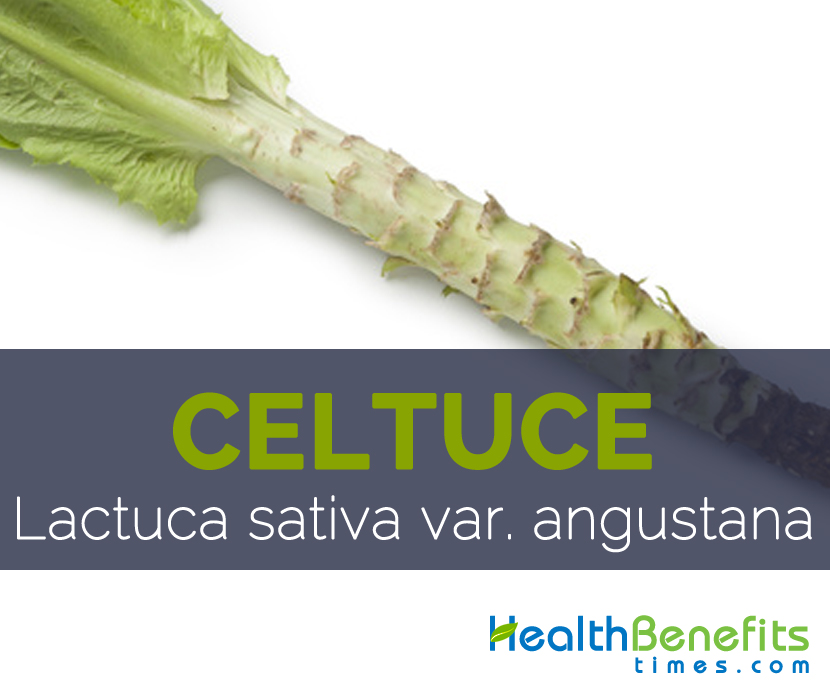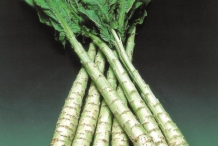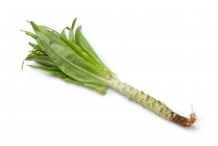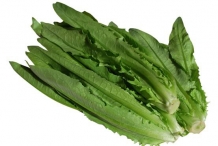| Celtuce Quick Facts | ||
|---|---|---|
| Name: | Celtuce | |
| Scientific Name: | Lactuca sativa var. angustana | |
| Origin | Southern China | |
| Colors | Light Green | |
| Shapes | Thick and tender stalks 15–20 cm and a diameter of around 3–4 cm | |
| Taste | Cross between lettuce and celery | |
| Calories | 18 Kcal./cup | |
| Major nutrients | Manganese (29.91%) Vitamin A (25.00%) Vitamin C (21.67%) Vitamin B9 (11.50%) Potassium (7.02%) |
|
| Proximity | Amount | % DV |
|---|---|---|
| Water | 94.5 g | N/D |
| Energy | 18 Kcal | N/D |
| Energy | 75 kJ | N/D |
| Protein | 0.85 g | 1.70% |
| Total Fat (lipid) | 0.3 g | 0.86% |
| Ash | 0.7 g | N/D |
| Carbohydrate | 3.65 g | 2.81% |
| Total dietary Fiber | 1.7 g | 4.47% |
| Minerals | Amount | % DV |
|---|---|---|
| Calcium, Ca | 39 mg | 3.90% |
| Iron, Fe | 0.55 mg | 6.88% |
| Magnesium, Mg | 28 mg | 6.67% |
| Phosphorus, P | 39 mg | 5.57% |
| Potassium, K | 330 mg | 7.02% |
| Sodium, Na | 11 mg | 0.73% |
| Zinc, Zn | 0.27 mg | 2.45% |
| Copper, Cu | 0.04 mg | 4.44% |
| Manganese, Mn | 0.688 mg | 29.91% |
| Selenium, Se | 0.9 µg | 1.64% |
| Vitamins | Amount | % DV |
|---|---|---|
| Water soluble Vitamins | ||
| Vitamin B1 (Thiamin) | 0.055 mg | 4.58% |
| Vitamin B2 (Riboflavin) | 0.07 mg | 5.38% |
| Vitamin B3 (Niacin) | 0.55 mg | 3.44% |
| Vitamin B5 (Pantothenic acid) | 0.183 mg | 3.66% |
| Vitamin B6 (Pyridoxine) | 0.05 mg | 3.85% |
| Vitamin B9 (Folate, Folic acid) | 46 µg | 11.50% |
| Folate, DEF | 46 µg | N/D |
| Vitamin C (Ascorbic acid) | 19.5 mg | 21.67% |
| Fat soluble Vitamins | ||
| Vitamin A, RAE | 175 µg | 25.00% |
| Vitamin A, IU | 3500 IU | N/D |
| Lipids | Amount | % DV |
|---|---|---|
| Phytosterols | 11 mg | N/D |
| Amino Acids | Amount | % DV |
|---|---|---|
| Tryptophan | 0.006 g | 1.36% |
| Threonine | 0.039 g | 2.22% |
| Isoleucine | 0.055 g | 3.29% |
| Leucine | 0.052 g | 1.41% |
| Lysine | 0.055 g | 1.64% |
| Methionine | 0.01 g | N/D |
| Cystine | 0.01 g | N/D |
| Phenylalanine | 0.036 g | N/D |
| Tyrosine | 0.021 g | N/D |
| Valine | 0.046 g | 2.18% |
| Arginine | 0.046 g | N/D |
| Histidine | 0.015 g | 1.22% |
| Alanine | 0.037 g | N/D |
| Aspartic acid | 0.093 g | N/D |
| Glutamic acid | 0.119 g | N/D |
| Glycine | 0.037 g | N/D |
| Proline | 0.032 g | N/D |
| Serine | 0.026 g | N/D |
Health Benefits of Celtuce
Celtuce is Manganese and vitamin C rich vegetable which is used to deal with many health problems. Frequent consumption of Celtuce is considered extremely beneficial to remain healthy and happy.
How to Eat
- Celtuce can be consumed raw or cooked.
- Leaves are normally steamed or stir-fried in high heat because of their bitter taste.
- Leaves are also used as bitter accent in a green salad.
- Stems are used as a substitute for celery in traditional French soups or salads.
- Stems are comparable to asparagus when they are steamed.
- Due to its mild flavor, stems are used to complement stir fry dishes.
- Celtuce is used in stir-fries and soups, consumed fresh or pickled.
- Leaves can be pulled from the stem as the plant grows and used in salads, or lightly cooked.
- Fleshy stem is cut into sections and boiled or stewed in China.
Celtuce – Lactuca sativa var. angustana Facts
Celtuce is an annual vegetable that prefers moist soil deeply enriched with well-rotted manure. Since its taste is just like a cross between lettuce and celery it can be used in numerous food recipes. It is a healthy and nutritious addition for your daily diet.
| Name | Celtuce |
|---|---|
| Scientific Name | Lactuca sativa var. angustana |
| Native | Southern China |
| Common/English Name | Asparagus lettuce, stem lettuce, Chinese lettuce or celery lettuce |
| Name in Other Languages | China: wosun |
| Plant Growth Habit | Annual Vegetable |
| Growing Climate | Grows best in cool season in cool and moist locations. |
| Soil | Moist, well-drained, deeply enriched with well-rotted manure. |
| Plant Size | 25-30 cm high. |
| Stem Shape and Size | Thick and tender stalks 15–20 cm and a diameter of around 3–4 cm. |
| Stem Color | Light Green |
| Stem skin | Woody skin |
| Stem weight | About 1 Kg |
| Stem Flavor | Crisp, moist, and mildly flavored |
| Stem Taste | Taste is like a cross between lettuce and celery |
| Leaf | Large butter head type, Dark green, lime green, AND deep red leaves. |
| Varieties/Types | Balady aswan and Max Green |
| Major Nutrition | Manganese, Mn 0.688 mg (29.91%) Vitamin A, RAE 175 µg (25.00%) Vitamin C (Ascorbic acid) 19.5 mg (21.67%) Vitamin B9 (Folate, Folic acid) 46 µg (11.50%) Potassium, K 330 mg (7.02%) Iron, Fe 0.55 mg (6.88%) Magnesium, Mg 28 mg (6.67%) Phosphorus, P 39 mg (5.57%) Vitamin B2 (Riboflavin) 0.07 mg (5.38%) Vitamin B1 (Thiamin) 0.055 mg (4.58%) |
| Health Benefits | |
| Calories in 1cup (100gm) | 18 Kcal |
References:
https://en.wikipedia.org/wiki/Celtuce
http://garden.org/plants/view/150213/Celtuce-Lactuca-sativa-var-angustana-Cracoviensis/
https://www.rhs.org.uk/advice/grow-your-own/vegetables/celtuce





